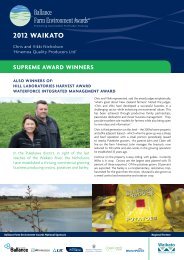Dairy's role in sustaining New Zealand - Fonterra
Dairy's role in sustaining New Zealand - Fonterra
Dairy's role in sustaining New Zealand - Fonterra
Create successful ePaper yourself
Turn your PDF publications into a flip-book with our unique Google optimized e-Paper software.
D Dairy’s <strong>role</strong> <strong>in</strong> generat<strong>in</strong>g growth<br />
It generates jobs<br />
• The dairy sector employs around 35,000 workers, exclud<strong>in</strong>g those who are self-employed<br />
(which could be up to 10,000 people). The sector will <strong>in</strong>directly support many more jobs<br />
<strong>in</strong> <strong>in</strong>dustries that supply dairy, and that experience the benefits of additional <strong>in</strong>come<br />
flow<strong>in</strong>g <strong>in</strong>to the region due to dairy volume and/or price growth.<br />
• It provides more jobs than each of the f<strong>in</strong>ance and accommodation sectors; around 65%<br />
more than the sheep and beef farm<strong>in</strong>g sector; 75% more than the fruit grow<strong>in</strong>g sector<br />
and double the jobs <strong>in</strong> the wood process<strong>in</strong>g sector.<br />
• In districts such as South Taranaki, Waimate, Otorohanga and Matamata-Piako, the dairy<br />
sector directly accounts for between 1 <strong>in</strong> 4 and 1 <strong>in</strong> 5 of the total number of jobs <strong>in</strong> the<br />
region.<br />
• A $1 per kg payout <strong>in</strong>crease results <strong>in</strong> the wealthier dairy sector and upstream and<br />
downstream <strong>in</strong>dustries employ<strong>in</strong>g approximately 4,600 more full time equivalent workers.<br />
It creates export earn<strong>in</strong>gs that improve Kiwis’ standard of liv<strong>in</strong>g<br />
• Dairy exports were $10.4 billion <strong>in</strong> calendar year 2009, account<strong>in</strong>g for around 26% of NZ’s<br />
total goods exports.<br />
• This contribution far outstrips that of any other goods export sector. Dairy exports are<br />
twice those of the meat sector, over 6 times larger than all fruit exports, n<strong>in</strong>e times larger<br />
than w<strong>in</strong>e exports, twelve times larger than alum<strong>in</strong>ium exports and 17 times larger than<br />
wool exports.<br />
• In fact, dairy exports are about the same as the sum of the next four largest export<br />
sectors: meat, wood, m<strong>in</strong>eral fuels (oil) and fruit & nuts.<br />
• Through its export earn<strong>in</strong>gs, the dairy sector makes a positive contribution to narrow<strong>in</strong>g<br />
the current account deficit. Without this export growth, <strong>New</strong> <strong>Zealand</strong> would have had to<br />
face <strong>in</strong>creased foreign liabilities and <strong>in</strong>terest on foreign debt.<br />
• A smaller deficit reduces <strong>New</strong> <strong>Zealand</strong>’s country risk premium on mortgage and other<br />
borrow<strong>in</strong>g costs, which benefits all households and firms that are borrowers.<br />
• The volume growth <strong>in</strong> the dairy sector over the last decade has resulted <strong>in</strong> <strong>New</strong> <strong>Zealand</strong><br />
households be<strong>in</strong>g a cumulative $6.4 billion better off than if dairy activity had stagnated<br />
at 1999 levels.<br />
• A $1 dairy payout <strong>in</strong>crease delivers additional <strong>in</strong>come of over $270 per year of additional<br />
spend<strong>in</strong>g per man, woman and child <strong>in</strong> <strong>New</strong> <strong>Zealand</strong>. This year’s <strong>in</strong>crease of $1.17 per kg<br />
will generate an extra $316 per person <strong>in</strong> <strong>New</strong> <strong>Zealand</strong>.<br />
It fills the tax coffers<br />
• The dairy sector generates a substantial amount of tax revenue for the government,<br />
through the <strong>in</strong>come taxes of farmers, corporate taxes of processors, and the GST and<br />
other taxes on the <strong>in</strong>come and spend<strong>in</strong>g that dairy stimulates <strong>in</strong> the rest of the economy.<br />
• And because the sector has raised taxation revenue, benefits flow not just to the dairy<strong>in</strong>g<br />
districts but across the country as a whole.<br />
• Increased tax revenue com<strong>in</strong>g <strong>in</strong> means more money to spend on essential services such<br />
as schools, hospitals and police. In 2009, these sectors are 0.7%, 0.6% and 0.2% better off<br />
because of the growth <strong>in</strong> the dairy sector over the past decade.
















